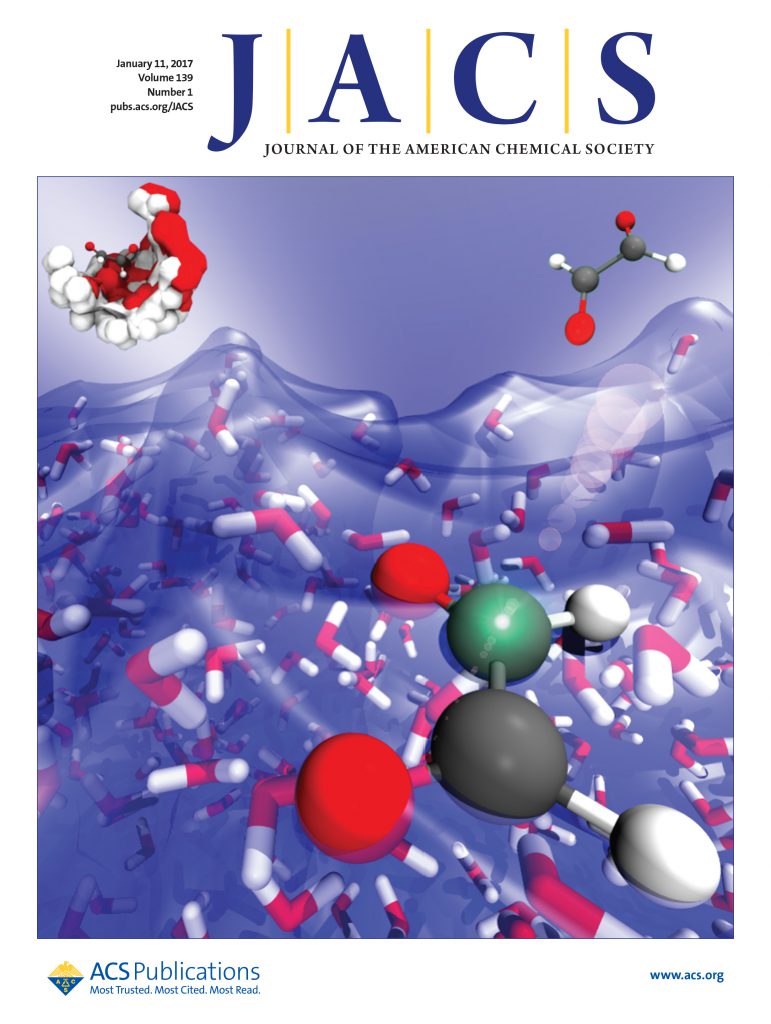Role of Oxide-Derived Cu on the Initial Elementary Reaction Intermediate During Catalytic CO2 Reduction
IF 14.4
1区 化学
Q1 CHEMISTRY, MULTIDISCIPLINARY
引用次数: 0
Abstract
The catalytic role of oxide-derived Cu (OD-Cu) in promoting CO2 reduction (CO2R) to C2+ products has been appreciated for decades. However, the dynamic evolution of the surface oxidation states, together with their real correlation to the binding of reaction intermediates, remains unclear due to technical challenges. Here, we show the time-resolved spectroscopic signatures of key OD-Cu-CO2•– intermediates during catalytic CO2 reduction through one electron transfer from nanoseconds to seconds time scale. We generated the initial intermediate CO2•– radicals in the bulk solution and monitored the interfacial reaction kinetics with well-defined OD-Cu (Cu(0), Cu(I), and Cu(II)) nanoparticles. Combined with molecular simulations, transient absorption profiles analysis reveals that Cu(I) induced a faster CO2•– radical coupling reaction than Cu(0), whereas Cu(II) is only reduced to Cu(I) by the CO2•– radical. Furthermore, the newly developed multistep cumulative pulse methodology uncovered the transition in chemical states of mixed OD-Cu during radical coupling reactions. This pulse radiolysis study provides compelling evidence for the beneficial role of subsurface oxides in early time catalytic CO2 transformation.

氧化物衍生的铜在催化二氧化碳还原过程中对初始基本反应中间体的作用
几十年来,氧化物衍生铜(OD-Cu)在促进二氧化碳还原(CO2R)生成 C2+ 产物方面的催化作用一直备受关注。然而,由于技术上的挑战,表面氧化态的动态演变及其与反应中间产物结合的真正相关性仍不清楚。在此,我们展示了在催化二氧化碳还原过程中,通过一次电子转移,从纳秒级到秒级的关键 OD-Cu-CO2- 中间产物的时间分辨光谱特征。我们在大体积溶液中生成了最初的 CO2--中间自由基,并用定义明确的 OD-Cu(Cu(0)、Cu(I) 和 Cu(II))纳米粒子监测了界面反应动力学。结合分子模拟、瞬态吸收曲线分析发现,与 Cu(0) 相比,Cu(I) 引发的 CO2 自由基偶联反应速度更快,而 Cu(II) 只被 CO2 自由基还原成 Cu(I)。此外,新开发的多步累积脉冲方法揭示了自由基偶联反应过程中混合 OD-Cu 化学状态的转变。这项脉冲辐射分析研究为地表下氧化物在早期催化二氧化碳转化过程中的有利作用提供了令人信服的证据。
本文章由计算机程序翻译,如有差异,请以英文原文为准。
求助全文
约1分钟内获得全文
求助全文
来源期刊
CiteScore
24.40
自引率
6.00%
发文量
2398
审稿时长
1.6 months
期刊介绍:
The flagship journal of the American Chemical Society, known as the Journal of the American Chemical Society (JACS), has been a prestigious publication since its establishment in 1879. It holds a preeminent position in the field of chemistry and related interdisciplinary sciences. JACS is committed to disseminating cutting-edge research papers, covering a wide range of topics, and encompasses approximately 19,000 pages of Articles, Communications, and Perspectives annually. With a weekly publication frequency, JACS plays a vital role in advancing the field of chemistry by providing essential research.

 求助内容:
求助内容: 应助结果提醒方式:
应助结果提醒方式:


